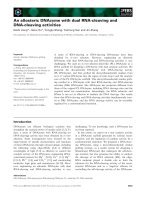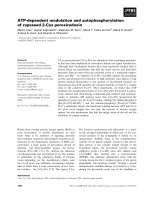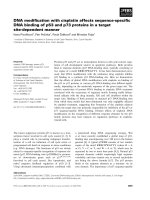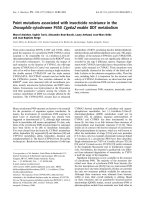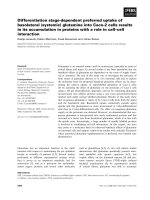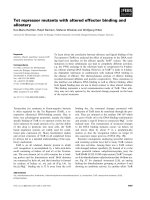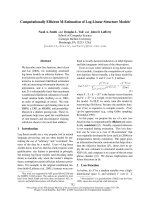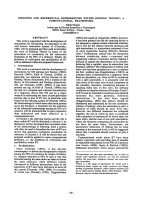Báo cáo khoa học: "Tagging Urdu Text with Parts of Speech: A Tagger Comparison" doc
Bạn đang xem bản rút gọn của tài liệu. Xem và tải ngay bản đầy đủ của tài liệu tại đây (115.65 KB, 9 trang )
Proceedings of the 12th Conference of the European Chapter of the ACL, pages 692–700,
Athens, Greece, 30 March – 3 April 2009.
c
2009 Association for Computational Linguistics
Tagging Urdu Text with Parts of Speech: A Tagger Comparison
Hassan Sajjad
Universität Stuttgart
Stuttgart. Germany
Helmut Schmid
Universität Stuttgart
Stuttgart, Germany
Abstract
In this paper, four state-of-art probabilistic
taggers i.e. TnT tagger, TreeTagger, RF tagger
and SVM tool, are applied to the Urdu lan-
guage. For the purpose of the experiment, a
syntactic tagset is proposed. A training corpus
of 100,000 tokens is used to train the models.
Using the lexicon extracted from the training
corpus, SVM tool shows the best accuracy of
94.15%. After providing a separate lexicon of
70,568 types, SVM tool again shows the best
accuracy of 95.66%.
1 Urdu Language
Urdu belongs to the Indo-Aryan language family.
It is the national language of Pakistan and is one
of the official languages of India. The majority
of the speakers of Urdu spread over the area of
South Asia, South Africa and the United King-
dom
1
.
Urdu is a free order language with general
word order SOV. It shares its phonological, mor-
phological and syntactic structures with Hindi.
Some linguists considered them as two different
dialects of one language (Bhatia and Koul,
2000). However, Urdu is written in Perso-arabic
script and inherits most of the vocabulary from
Arabic and Persian. On the other hand, Hindi is
written in Devanagari script and inherits vocabu-
lary from Sanskrit.
Urdu is a morphologically rich language.
Forms of the verb, as well as case, gender, and
number are expressed by the morphology. Urdu
represents case with a separate character after the
head noun of the noun phrase. Due to their sepa-
rate occurrence and their place of occurrence,
they are sometimes considered as postpositions.
Considering them as case markers, Urdu has no-
1
code=URD
minative, ergative, accusative, dative, instrumen-
tal, genitive and locative cases (Butt, 1995: pg
10). The Urdu verb phrase contains a main verb,
a light verb describing the aspect, and a tense
verb describing the tense of the phrase (Hardie,
2003; Hardie, 2003a).
2 Urdu Tagset
There are various questions that need to be ans-
wered during the design of a tagset. The granu-
larity of the tagset is the first problem in this re-
gard. A tagset may consist either of general parts
of speech only or it may consist of additional
morpho-syntactic categories such as number,
gender and case. In order to facilitate the tagger
training and to reduce the lexical and syntactic
ambiguity, we decided to concentrate on the syn-
tactic categories of the language. Purely syntactic
categories lead to a smaller number of tags which
also improves the accuracy of manual tagging
2
(Marcus et al., 1993).
Urdu is influenced from Arabic, and can
be considered as having three main parts of
speech, namely noun, verb and particle (Platts,
1909; Javed, 1981; Haq, 1987). However, some
grammarians proposed ten main parts of speech
for Urdu (Schmidt, 1999). The work of Urdu
grammar writers provides a full overview of all
the features of the language. However, in the
perspective of the tagset, their analysis is lacking
the computational grounds. The semantic, mor-
phological and syntactic categories are mixed in
their distribution of parts of speech. For example,
Haq (1987) divides the common nouns into sit-
uational (smile, sadness, darkness), locative
(park, office, morning, evening), instrumental
(knife, sword) and collective nouns (army, data).
In 2003, Hardie proposed the first com-
putational part of speech tagset for Urdu (Hardie,
2
A part of speech tagger for Indian languages, available at
/iiit_tagset_guidelines.pdf
692
2003a). It is a morpho-syntactic tagset based on
the EAGLES guidelines. The tagset contains 350
different tags with information about number,
gender, case, etc. (van Halteren, 2005). The
EAGLES guidelines are based on three levels,
major word classes, recommended attributes and
optional attributes. Major word classes include
thirteen tags: noun, verb, adjective, pro-
noun/determiner, article, adverb, adposition, con-
junction, numeral, interjection, unassigned, resi-
dual and punctuation. The recommended
attributes include number, gender, case, finite-
ness, voice, etc.
3
In this paper, we will focus on
purely syntactic distributions thus will not go
into the details of the recommended attributes of
the EAGLES guidelines. Considering the
EAGLES guidelines and the tagset of Hardie in
comparison with the general parts of speech of
Urdu, there are no articles in Urdu. Due to the
phrase level and semantic differences, pronoun
and demonstrative are separate parts of speech in
Urdu. In the Hardie tagset, the possessive pro-
nouns like ήϴϣ /mera/ (my), έΎ٬ϤΗ /tumhara/
(your), έΎϤ٫ /humara/ (our) are assigned to the
category of possessive adjective. Most of the Ur-
du grammarians consider them as pronouns
(Platts, 1909; Javed, 1981; Haq, 1987). However,
all these possessive pronouns require a noun in
their noun phrase, thus show a similar behavior
as demonstratives. The locative and temporal
adverbs (؏Ύ٬ϳ /yahan/ (here), ؏Ύ٫ϭ /wahan/ (there),
Ώ /ab/ (now), etc.) and, the locative and tempor-
al nouns (Βλ /subah/ (morning), ϡΎη /sham/
(evening), ήϬ̳ /gher/ (home)) appear in a very
similar syntactic context. In order to keep the
structure of pronoun and noun consistent, loca-
tive and temporal adverbs are treated as pro-
nouns. The tense and aspect of a verb in Urdu is
represented by a sequence of auxiliaries. Consid-
er the example
4
:
ف٫ Ύ٫έ ΎΟ ΎΗή̯ ϡΎ̯ ϥΎΟ
HairahaJakerta kam Jan
Is Doing Kept Work John
John is kept on doing work
“Table 1: The aspect of the verb ΎΗή̯ /kerta/
(doing) is represented by two separate words ΎΟ
/ja/ and Ύ٫έ /raha/ and the last word of the sen-
tence ف٫ /hai/ (is) shows the tense of the verb.”
3
The details on the EAGLES guidelines can be found at:
/>
4
Urdu is written in right to left direction.
The above considerations lead to the following
tagset design for Urdu. The general parts of
speech are noun, pronoun, demonstrative, verb,
adjective, adverb, conjunction, particle, number
and punctuation. The further refinement of the
tagset is based on syntactic properties. The mor-
phologically motivated features of the language
are not encoded in the tagset. For example, an
Urdu verb has 60 forms which are morphologi-
cally derived from its root form. All these forms
are annotated with the same category i.e. verb.
During manual tagging, some words are
hard for the linguist to disambiguate reliably. In
order to keep the training data consistent, such
words are assigned a separate tag. For instance,
the semantic marker فγ /se/ gets a separate tag
due to its various confusing usages such as loca-
tive and instrumental (Platts, 1909).
The tagset used in the experiments reported
in this paper contains 42 tags including three
special tags. Nouns are divided into noun (NN)
and proper name (PN). Demonstratives are di-
vided into personal (PD), KAF (KD), adverbial
(AD) and relative demonstratives (RD). All four
categories of demonstratives are ambiguous with
four categories of pronouns. Pronouns are di-
vided into six types i.e. personal (PP), reflexive
(RP), relative (REP), adverbial (AP), KAF (KP)
and adverbial KAF (AKP) pronouns. Based on
phrase level differences, genitive reflexive (GR)
and genitive (G) are kept separate from pro-
nouns. The verb phrase is divided into verb, as-
pectual auxiliaries and tense auxiliaries. Numer-
als are divided into cardinal (CA), ordinal (OR),
fractional (FR) and multiplicative (MUL). Con-
junctions are divided into coordinating (CC) and
subordinating (SC) conjunctions. All semantic
markers except فγ /se/ are kept in one category.
Adjective (ADJ), adverb (ADV), quantifier (Q),
measuring unit (U), intensifier (I), interjection
(INT), negation (NEG) and question words
(QW) are handled as separate categories. Adjec-
tival particle (A), KER (KER), SE (SE) and
WALA (WALA) are ambiguous entities which
are annotated with separate tags. A complete list
of the tags with the examples is given in appen-
dix A. The examples of the weird categories such
as WALA, KAF pronoun, KAF demonstratives,
etc. are given in appendix B.
3 Tagging Methodologies
The work on automatic part of speech tagging
started in early 1960s. Klein and Simmons
693
(1963) rule based POS tagger can be considered
as the first automatic tagging system. In the rule
based approach, after assigning each word its
potential tags, a list of hand written disambigua-
tion rules are used to reduce the number of tags
to one (Klein and Simmons, 1963; Green and
Rubin, 1971; Hindle, 1989; Chanod and Tapa-
nainen 1994). A rule based model has the disad-
vantage of requiring lots of linguistic efforts to
write rules for the language.
Data-driven approaches resolve this prob-
lem by automatically extracting the information
from an already tagged corpus. Ambiguity be-
tween the tags is resolved by selecting the most
likely tag for a word (Bahl and Mercer, 1976;
Church, 1988; Brill, 1992). Brill’s transformation
based tagger uses lexical rules to assign each
word the most frequent tag and then applies con-
textual rules over and over again to get a high
accuracy. However, Brill’s tagger requires train-
ing on a large number of rules which reduces the
efficiency of machine learning process. Statistic-
al approaches usually achieve an accuracy of
96%-97% (Hardie, 2003: 295). However, statis-
tical taggers require a large training corpus to
avoid data sparseness. The problem of low fre-
quencies can be resolved by applying different
methods such as smoothing, decision trees, etc.
In the next section, an overview of the statistical
taggers is provided which are evaluated on the
Urdu tagset.
3.1 Probabilistic Disambiguation
The Hidden Markov model is the most widely
used method for statistical part of speech tag-
ging. Each tag is considered as a state. States are
connected by transition probabilities which
represent the cost of moving from one state to
another. The probability of a word having a par-
ticular tag is called lexical probability. Both, the
transitional and the lexical probabilities are used
to select the tag of a particular word.
As a standard HMM tagger, The TnT
tagger is used for the experiments. The TnT tag-
ger is a trigram HMM tagger in which the transi-
tion probability depends on two preceding tags.
The performance of the tagger was tested on
NEGRA corpus and Penn Treebank corpus. The
average accuracy of the tagger is 96% to 97%
(Brants, 2000).
The second order Markov model used by
the TnT tagger requires large amounts of tagged
data to get reasonable frequencies of POS tri-
grams. The TnT tagger smooths the probability
with linear interpolation to handle the problem of
data sparseness. The Tags of unknown words are
predicted based on the word suffix. The longest
ending string of an unknown word having one or
more occurrences in the training corpus is consi-
dered as a suffix. The tag probabilities of a suffix
are evaluated from all the words in the training
corpus (Brants, 2000).
In 1994, Schmid proposed a probabilistic
part of speech tagger very similar to a HMM
based tagger. The transition probabilities are cal-
culated by decision trees. The decision tree
merges infrequent trigrams with similar contexts
until the trigram frequencies are large enough to
get reliable estimates of the transition probabili-
ties. The TreeTagger uses an unknown word
POS guesser similar to that of the TnT tagger.
The TreeTagger was trained on 2 million words
of the Penn-Treebank corpus and was evaluated
on 100,000 words. Its accuracy is compared
against a trigram tagger built on the same data.
The TreeTagger showed an accuracy of 96.06%
(Schmid, 1994a).
In 2004, Giménez and Màrquez pro-
posed a part of speech tagger (SVM tool) based
on support vector machines and reported accura-
cy higher than all state-of-art taggers. The aim of
the development was to have a simple, efficient,
robust tagger with high accuracy. The support
vector machine does a binary classification of the
data. It constructs an N-dimensional hyperplane
that separates the data into positive and negative
classes. Each data element is considered as a
vector. Those vectors which are close to the se-
parating hyperplane are called support vectors
5
.
A support vector machine has to be
trained for each tag. The complexity is controlled
by introducing a lexicon extracted from the train-
ing data. Each word tag pair in the training cor-
pus is considered as a positive case for that tag
class and all other tags in the lexicon are consi-
dered negative cases for that word. This feature
avoids generating useless cases for the compari-
son of classes.
The SVM tool was evaluated on the
English Penn Treebank. Experiments were con-
ducted using both polynomial and linear kernels.
When using n-gram features, the linear kernel
showed a significant improvement in speed and
accuracy. Unknown words are considered as the
most ambiguous words by assigning them all
open class POS tags. The disambiguation of un-
knowns uses features such as prefixes, suffixes,
5
Andrew Moore:
694
upper case, lower case, word length, etc. On the
Penn Treebank corpus, SVM tool showed an ac-
curacy of 97.16% (Giménez and Màrquez,
2004).
In 2008, Schmid and Florian proposed a
probabilistic POS tagger for fine grained tagsets.
The basic idea is to consider POS tags as sets of
attributes. The context probability of a tag is the
product of the probabilities of its attributes. The
probability of an attribute given the previous tags
is estimated with a decision tree. The decision
tree uses different context features for the predic-
tion of different attributes (Schmid and Laws,
2008).
The RF tagger is well suited for lan-
guages with a rich morphology and a large fine
grained tagset. The RF tagger was evaluated on
the German Tiger Treebank and Czech Academ-
ic corpus which contain 700 and 1200 POS tags,
respectively. The RF tagger achieved a higher
accuracy than TnT and SVMTool.
Urdu is a morphologically rich language.
Training a tagger on a large fine grained tagset
requires a large training corpus. Therefore, the
tagset which we are using for these experiments
is only based on syntactic distributions. Howev-
er, it is always interesting to evaluate new dis-
ambiguation ideas like RF tagger on different
languages.
4 Experiments
A corpus of approx 110,000 tokens was taken
from a news corpus (www.jang.com.pk). In the
filtering phase, diacritics were removed from the
text and normalization was applied to keep the
Unicode of the characters consistent. The prob-
lem of space insertion and space deletion was
manually solved and space is defined as the word
boundary. The data was randomly divided into
two parts, 90% training corpus and 10% test cor-
pus. A part of the training set was also used as
held out data to optimize the parameters of the
taggers. The statistics of the training corpus and
test corpus are shown in table 2 and table 3. The
optimized parameters of the TreeTagger are con-
text size 2, with minimum information gain for
decision tree 0.1 and information gain at leaf
node 1.4. For TnT, a default trigram tagger is
used with suffix length of 10, sparse data mode 4
with lambda1 0.03 and lambda2 0.4. The RF
tagger uses a context length of 4 with threshold
of suffix tree pruning 1.5. The SVM tool is
trained at right to left direction with model 4.
Model 4 improves the detection of unknown
words by artificially marking some known words
as unknown words and then learning the model.
Training corpus Test corpus
Tokens 100,000 9000
Types 7514 1931
Unknown
Tokens
754
Unknown
Types
444
“Table 2: Statistics of training and test data.”
Tag Total Un-
known
Tag To-
tal
Un-
known
NN 2537 458 PN 459 101
P 1216 0 AA 379 0
VB 971 81 TA 285 0
ADJ 510 68 ADV 158 21
“Table 3: Eight most frequent tags in the test
corpus.”
In the first experiment, no external lexicon was
provided. The types from the training corpus
were used as the lexicon by the tagger. SVM tool
showed the best accuracy for both known and
unknown words. Table 4 shows the accuracies of
all the taggers. The baseline result where each
word is annotated with its most frequent tag, ir-
respective of the context, is 88.0%.
TnT
tagger
TreeTagger RF tagger SVM
tagger
93.40% 93.02% 93.28% 94.15%
Known
95.78% 95.60% 95.68% 96.15%
Unknown
68.44% 65.92% 68.08% 73.21%
“Table 4: Accuracies of the taggers without us-
ing any external lexicon. SVM tool shows the
best result for both known and unknown words.”
The taggers show poor accuracy while detecting
proper names. In most of the cases, proper name
is confused with adjective and noun. This is be-
cause in Urdu, there is no clear distinction be-
tween noun and proper name. Also, the usage of
an adjective as a proper name is a frequent phe-
nomenon in Urdu. The accuracies of open class
tags are shown in table 5. The detailed discussion
on the results of the taggers is done after provid-
ing an external lexicon to the taggers.
695
Tag TnT
tagger
Tree-
Tagger
RF
tagger
SVM
tagger
VB 93.20% 91.86% 92.68% 94.23%
NN 94.12% 96.21% 93.89% 96.45%
PN 73.20% 66.88% 72.77% 68.62%
ADV 75.94% 72.78% 74.68% 72.15%
ADJ 85.67% 80.78% 86.5% 85.88%
“Table 5: Accuracies of open class tags without
having an external lexicon”
In the second stage of the experiment, a large
lexicon consisting of 70,568 types was pro-
vided
6
. After adding the lexicon, there are 112
unknown tokens and 81 unknown types in the
test corpus
7
. SVM tool again showed the best
accuracy of 95.66%. Table 6 shows the accuracy
of the taggers. The results of open class words
significantly improve due to the smaller number
of unknown words in the test corpus. The total
accuracy of open class tags and their accuracy on
unknown words are given in table 7 and table 8
respectively.
TnT tag-
ger
Tree-
Tagger
RF tagger SVM
tool
94.91% 95.17% 95.26% 95.66%
Known
95.42% 95.65% 95.66% 96.11%
Unknown
56.25% 58.04% 64.60% 61.61%
“Table 6: Accuracies of the taggers after adding
the lexicon. SVM tool shows the best accuracy
for known word disambiguation. RF tagger
shows the best accuracy for unknown words.”
Tag TnT
tagger
Tree-
Tagger
RF
tagger
SVM
tool
VB 95.88% 95.88% 96.58% 96.80%
NN 94.64% 95.85% 94.79% 96.64%
PN 86.92% 79.73% 84.96% 81.70%
ADV 82.28% 79.11% 81.64% 81.01%
ADJ 91.59% 89.82% 92.37% 88.26%
“Table 7: Accuracies of open class tags after
adding an external lexicon.”
6
Additional lexicon is taken from CRULP, Lahore, Paki-
stan (www.crulp.org).
7
The lexicon was added by using the default settings pro-
vided by each tagger. No probability distribution informa-
tion was given with the lexicon.
Tag TnT
tagger
Tree-
Tagger
RF
tagger
SVM
tool
VB 28.57% 0.00% 42.86% 42.86%
NN 74.47% 95.74% 80.85% 80.85%
PN 68.18% 54.54% 63.63% 50.00%
ADV 8.33% 0.00% 8.33% 0.00%
ADJ 30.00% 20.00% 70.00% 80.00%
“Table 8: Accuracies of open class tags on un-
known words. The number of unknown words
with tag VB and ADJ are less than 10 in this ex-
periment.”
The results of the taggers are analyzed by finding
the most frequently confused pairs for all the
taggers. It includes both the known and unknown
words. Only those pairs are added in the table
which have an occurrence of more than 10. Table
9 shows the results.
Confused
pair
TnT
tagger
Tree-
Tagger
RF
tagger
SVM
tool
NN ADJ 85 87 87 95
NN PN 118 140 129 109
NN ADV 12 15 13 15
NN VB 14 17 12 12
VB TA 12 0 0 0
KER P 14 14 14 0
ADV ADJ 11 14 13 11
PD PP 26 26 30 14
“Table 9: Most frequently confused tag pairs
with total number of occurrences.”
5
Discussion
The output of table 9 can be analyzed in many
ways e.g. ambiguous tags, unknown words, open
class tags, close class tags, etc. In the close class
tags, the most frequent errors are between de-
monstrative and pronoun, and between KER tag
and semantic marker (P). The difference between
demonstrative and pronoun is at the phrase level.
Demonstratives are followed by a noun which
belongs to the same noun phrase whereas pro-
nouns form a noun phrase by itself. Taggers ana-
lyze the language in a flat structure and are una-
ble to handle the phrase level differences. It is
interesting to see that the SVM tool shows a
clear improvement in detecting the phrase level
differences over the other taggers. It might be
due to the SVM tool ability to look not only at
696
the neighboring tags but at the neighboring
words as well.
(a)
ف̳ Ύ̳ؐϴ ΎϧΎ̳ ̱Ϯϟ ϩϭ
Gay gayain Gana log Voh
TA VB NN NN PD
Will sing Song people Those
Those people will sing a song.
)b(
ف̳ Ύ̳ؐϴ ΎϧΎ̳ ϩϭ
Gay Gayain gana Voh
TA VB NN PP
Will Sing Song those
Those will sing a song.
“Table 10: The word ϩϭ /voh/ is occurring both as
pronoun and demonstrative. In both of the cases,
it is followed by a noun. But looking at the
phrases, demonstrative ϩϭ has the noun inside the
noun phrase.”
The second most frequent error among the closed
class tags is the distinction between the KER tag
ف̯ /kay/ and the semantic marker ف̯ /kay/. The
KER tag always takes a verb before it and the
semantic marker always takes a noun before it.
The ambiguity arises when a verbal noun occurs.
In the tagset, verbal nouns are handled as verb.
Syntactically, verbal nouns occur at the place of
a noun and can also take a semantic marker after
them. This decreases the accuracy in two ways;
the wrong disambiguation of KER tag and the
wrong disambiguation of unknown verbal nouns.
Due to the small amount of training data, un-
known words are frequent in the test corpus.
Whenever an unknown word occurs at the place
of a noun, the most probable tag for that word
will be noun which is wrong in our case. Table
11 shows an example of such a scenario.
)a(
ΪόΑ ف̯ فϧή̯ ϡΎ̯
baad Kay kernay kam
NN P VB NN
after doing work
After doing work
)b(
ف̯ ή̯ ϡΎ̯
kay ker kam
KER VB NN
Doing work
(After) doing work
“Table 11: (a) Verbal noun with semantic mark-
er, (b) syntactic structure of KER tag.”
8
All the taggers other than the SVM tool have
difficulties to disambiguate between KER tags
and semantic markers.
)a(
ϭΩ ̭έϮΧ Ϯ̯ ؏Ϯ̳Ϯϟ ΪϨϤΗέϭήο
do khoraak Ko log zarorat-
mand
VB NN P NN ADJ
give food To people needy
Give food to the needy people
(b)
ϭΩ ̭έϮΧ Ϯ̯ ΪϨϤΗέϭήο
do khoraak ko zaroratmand
VB NN P NN
give food To needy
Give food to the needy
“Table 12: (a) Occurrence of adjective with
noun, (b) dropping of main noun from the noun
phrase. In that case, adjective becomes the
noun.”
Coming to open class tags, the most frequent
errors are between noun and the other open class
tags in the noun phrase like proper noun, adjec-
tive and adverb. In Urdu, there is no clear dis-
tinction between noun and proper noun. The
phenomenon of dropping of words is also fre-
quent in Urdu. If a noun in a noun phrase is
dropped, the adjective becomes a noun in that
phrase (see table 12). The ambiguity between
noun and verb is due to verbal nouns as ex-
plained above (see table 11).
6 Conclusion
In this paper, probabilistic part of speech tagging
technologies are tested on the Urdu language.
The main goal of this work is to investigate
whether general disambiguation techniques and
standard POS taggers can be used for the tagging
of Urdu. The results of the taggers clearly answer
this question positively. With the small training
corpus, all the taggers showed accuracies around
95%. The SVM tool shows the best accuracy in
8
One possible solution to this problem could be to intro-
duce a separate tag for verbal nouns which will certainly
remove the ambiguity between the KER tag and the seman-
tic marker and reduce the ambiguity between verb and
noun.
697
disambiguating the known words and the RF
tagger shows the best accuracy in detecting the
tags of unknown words.
Appendices
Appendix A. Urdu part of speech tagset
Following is the complete list of the tags of Ur-
du. There are some occurrences in which two
Urdu words are mapped to the same translation
of English. There are two reasons for that, ei-
ther the Urdu words have different case or there
is no significant meaning difference between
the two words which can be described by dif-
ferent English translations.
Tag Example
Personal demonstra-
tive (PD)
Ϣ٫ (we) ϢΗ ˬ (you) ̟ ˬ
(you
9
)؟ϳ ˬ(this) ϩϭ ˬ
(that)α ˬ (that)
Relative demonstra-
tive (RD)
ϮΟ (that)ϦΟ ˬ(that) ˬ
؏Ϯ٬ϨΟ(that)
Kaf demonstrative
(KD)
Ϧ̯ (whose)̶Ϯ̯ ˬ
(someone)
Adverbial demonstr-
ative (AD)
Ώ (now) ΐΗ ˬ (then) ˬ
ήϫΩ (here) ؏Ύ٬ϳ ˬ (here)
Noun (NN)
ίΎ٬Ο (ship) Ϧϴϣί ˬ (earth)
Ύ̯֑ϟ ˬ (boy) ή̡ϭ ˬ
(above)έΪϧ ˬ (inside) ˬ
ΖϴϤγ (with) Ρήρ ˬ (like)
Proper noun (PN)
̶ϨϣήΟ (Germany) ˬ
ϥΎΘδ̯Ύ̡ (Pakistan)
Personal pronoun
(PP)
ؐϴϣ (I)Ϣ٫ ˬ (we) ϢΗ ˬ (you) ˬ
̟ (you) ؟ϳ ˬ (he) ϩϭ ˬ
(he) α ˬ (he)
Reflexive pronoun
(RP)
ΩϮΧ (myself) ̟ ˬ
(myself)
Relative pronoun
(REP)
ϮΟ(that)ϦΟ ˬ(that) ˬ
؏Ϯ٬ϨΟ(that)
Adverbial pronoun
(AD)
Ώ (now) ΐΗ ˬ (then) ˬ
ήϫΩ (here) ؏Ύ٬ϳ ˬ (here)
Kaf pronoun (KP)
ϥϮ̯ (who) ̶Ϯ̯ ˬ
(someone) Ϧ̯ ˬ ˬ (which)
Adverbial kaf pro
(AKP)
ήϫΪ̯ (where) ΐ̯ ˬ
(when) Ύδϴ̯ ˬ (how)
Genitive reflexive
(GR)
ΎϨ̡ (my)
Genitives (G)
ήϴϣ (my) έΎϬϤΗ ˬ (your) ˬ
έΎϤ٫ (our) ήϴΗ ˬ (your)
Verb (VB)
ΎϨϬ̰ϟ (write) ΎΗΎϬ̯ ˬ (eat) ˬ
ΎΗΎΟ (go) Ύϧή̯ ˬ (do)
9
Polite form of you which is used while talking with the elders and
with the strangers
Aspectual auxiliary
(AA)
؟̰̩ ˬΎϧή̯ ˬΎ٫έ
10
Tense auxiliary (TA)
ف٫ (is) ؐϴ٫ ˬ (are) ΎϬΗ ˬ
(was) فϬΗ ˬ (were)
Adjective (ADJ)
ϢϟΎυ (cruel) ΕέϮμΑϮΧ ˬ
(beautiful) έϭΰϤ̯ ˬ
(weak)
Adverb (ADV)
Ζ٬Α (very) ΖϳΎ٬ϧ ˬ (very) ˬ
֑Α (very)
Quantifier (Q)
Ϭ̪̯ (some) ϡΎϤΗˬ (all) ˬ
فϨΗ (this much) Ϟ̯ ˬ
(total)
Cardinal (CA)
̮ϳ (one)ϭΩ ˬ (two) ϦϴΗ ˬ
(three)
Ordinal (OR)
ϼ٬̡ (first) ήγϭΩ ˬ
(second) ̵ήΧ ˬ (last)
Fractional (FR)
̶ΎϬΗϮ̩ (one fourth) ˬ
̶Ύϫվ(two and a half)
Multiplicative
(MUL)
ΎϨ̳ (times)ΎϨ̳Ω ˬ (two
times)
Measuring unit (U) ϮϠ̯(kilo)
Coordinating (CC) έϭ, (and) Ύϳ (or)
Subordinating (SC) ؟̯,(that) ؟̰ϧϮϴ̯ (because)
Intensifier (I) ϮΗ ˬ̶ϬΑ ˬ̶٫
Adjectival particle Ύγ (like)
KER ή̯ ˬف̯
Pre-title (PRT) ΕήπΣ (Mr.)؏Ύϴϣ ˬ (Mr.)
Post-title (POT) ̶Ο ΐΣΎλ ˬ (Mr.)
Case marker (P)
ˬفϧ ˬ ف̯ ˬ ̶̯ ˬ Ϯ̯ ˬ Ύ̯
̮Η ˬؐϴϣ ˬή̡ ˬ ̮ϠΗ
SE (SE) فγ
WALA (WALA) فϟϭ ˬ̶ϟϭ ˬϻϭ
Negation (NEG) ]؟ϧ ؐϴ٬ϧ ˬ[ (not/no)
Interjection (INT)
ϩϭ(hurrah) , ˬௌ ϥΎΤΒγ
ΎϬ̩ (Good)
Question word
(QW)
Ύϴ̯ (what) ؏Ϯϴ̯ ˬ (why)
Sentence marker
(SM)
‘.’, ‘?’
Phrase marker (PM) ‘,’ , ‘;’
DATE 2007, 1999
Expression (Exp): Any word or symbol which
is not handled in the tagset will be catered un-
der expression. It can be mathematical sym-
bols, digits, etc.
“Table 13: Tagset of Urdu”
10
They always occur with a verb and can not be translated stand-
alone.
698
Appendix B. Examples of WALA, Noun with
locative behavior, KAF pronoun and KAF
demonstrative and multiplicative.
WALA
ϻϭ:
Attributive Demonstrative Occupation
ϻϭ Εΰϋ ϻϭ ؟ϳ ϻϭ ϫΩϭΩ
Respectable This one Milk man
Manner Possession Time
ϻϭ ؟Θδ٫ ؏ϮՍϧΎ̯ϝϮϬ̡ ϻϭ έΎΒΧ ϻϭ Βλ
The one with the
manner “slow”
Flower with
thorns
Morning
newspaper
Place Doer
ΎΗϮΟ ϻϭ ή٫ΎΑ ϻϭ فϨϫ̡֑
Shoes which is
bought from
some other
country
The one whose
study
“Table 14: Examples of tag WALA”
Noun with locative behavior:
Adverb Noun
ϥΎ̯Ω ̶ϟϭ ف̪ϴϧ Ύϧ فγ ف̪ϴϧ
Down shop Coming from
downstairs
Postposition Noun
ف̪ϴϧ ف̯ ΰϴϣ ΎϧΎΟ ف̪ϴϧ
Under the table Goes down
“Table 15: Examples of noun with locative be-
havior
Multiplicative:
ΎϨ̳Ω فγ ϬΠϣ ϩϭ
)ΎϨ̳ϭΩ( لف٫ ΎՌϮϣ
He is two times fatter than me.
“Table 16: Example of Multiplicative
KAF pronoun and KAF demonstrative:
KAF pronoun
Ϯ̯ ؏Ϯ̳Ϯϟ Ϧ̯ ϡ فϬ̩ ؐϴ٫ فΘ̴ϟ ˮ
Which people like mangoes?
KAF Demonstrative
Ϯ̯ Ϧ̯ ϡ فϬ̩ ؐϴ٫ فΘ̴ϟ ˮ
Which one like mangoes?
Adverbial KAF pronoun
ϩϭ ف٫ Ύϴ̳ ήϫΪ̯ ˮ
Where did he go?
“Table 17: Examples of KAF pronoun and KAF
demonstrative
References
Bahl, L. R. and Mercer, R. L. 1976. Part of
speech assignment by a statistical decision algo-
rithm, IEEE International Symposium on Infor-
mation Theory, pp. 88-89.
Bhatia, TK and Koul, A. 2000. Colloquial Urdu.
London: Routledge.
Brants, Thorsten. 2000. TnT – a statistical part-
of-speech tagger. In Proceedings of the Sixth Ap-
plied Natural Language Processing Conference
ANLP-2000 Seattle, WA.
Brill, E. 1992. A simple rule-based part of
speech tagger, Department of Computer Science,
University of Pennsylvania.
Butt, M. 1995. The structure of complex predi-
cates in Urdu. CSLI, Stanford.
Chanod, Jean-Pierre and Tapananinen, Pasi
1994. Statistical and constraint-Based taggers for
French, Technical report MLTT-016, RXRC
Grenoble.
Church, K. W. 1988. A stochastic parts program
and noun phrase parser for unrestricted test, In
the proceedings of 2
nd
conference on Applied
Natural Language Processing, pp. 136-143.
Giménez and Màrquez. 2004. SVMTool: A gen-
eral POS tagger generator based on support vec-
tor machines. In Proceedings of the IV Interna-
tional Conference on Language Resources and
Evaluation (LREC’ 04), Lisbon, Portugal.
Green, B. and Rubin, G. 1971. Automated
grammatical tagging of English, Department of
Linguistics, Brown University.
699
Haq, M. Abdul. 1987. ϭΩέ ϮΤϧ ϭ ϑήλ, Amju-
man-e-Taraqqi Urdu (Hind).
Hardie, A. 2003. Developing a tag-set for auto-
mated part-of-speech tagging in Urdu. In Archer,
D, Rayson, P, Wilson, A, and McEnery, T (eds.)
Proceedings of the Corpus Linguistics 2003 con-
ference. UCREL Technical Papers Volume 16.
Department of Linguistics, Lancaster University,
UK.
Hardie, A. 2003a. The computational analysis of
morphosyntactic categories in Urdu, PhD thesis,
Lancaster University.
Hindle, D. 1989. Acquiring disambiguation rules
from text, Proceedings of 27
th
annual meeting of
Association for Computational Linguistics.
van Halteren, H, 2005. Syntactic Word Class
Tagging, Springer.
Javed, Ismat. 1981. Ίϧ ΪϋϮϗ ϭΩέ, Taraqqi Urdu
Bureau, New Delhi.
Klein, S. and Simmons, R.F. 1963. A computa-
tional approach to grammatical coding of English
words, JACM 10: pp. 334-347.
Marcus, M. P., Santorini, B. and Marcinkiewicz,
M. A. 1993. Building a large annotated corpus of
English: the Penn Treebank Computational Lin-
guistics 19, pp. 313-330
Platts, John T 1909. A grammar of the Hindusta-
ni or Urdu language, London.
Schmid, H. 1994. Probabilistic part-of-speech
tagging using decision tree, Institut für Maschi-
nelle Sprachverarbeitung, Universität Stuttgart,
Germany.
Schmid, H. 1994a. Part-of-speech tagging with
neural networks, In the Proceedings of Interna-
tional Conference on Computational Linguistics,
pp. 172-176, Kyoto, Japan.
Schmid, H. and Laws, F. 2008. Estimation of
conditional Probabilities with Decision Trees and
an Application to Fine-Grained POS tagging,
COLING 2008, Manchester, Great Britain.
Schmidt, RL 1999. Urdu: an essential grammar,
London: Routledge.
700
